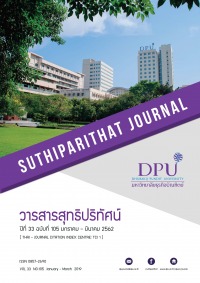การสร้างพันธมิตรร่วมและการพัฒนาศักยภาพของ แรงงาน: กรณีศึกษาการรวมกลุ่มของแรงงานในภาคเหนือ
คำสำคัญ:
การสร้างพันธมิตรร่วม, การรวมกลุ่มของแรงงาน, แรงงานที่ไม่เป็นทางการบทคัดย่อ
บทความเรื่องการสร้างพันธมิตรร่วมและการรวมกลุ่มของแรงงานในภาคเหนือ เป็นส่วนหนึ่งของงานวิจัยเกี่ยวกับแรงงานในเขตเชียงใหม่ ลำพูน มีวัตถุประสงค์เพื่อศึกษาการสร้างพันธมิตรร่วมและการรวมกลุ่มของแรงงานในภาคเหนือซึ่งเป็นเขตภูเขาอุตสาหกรรมขนาดกลางขนาดย่อมรวมทั้งธุรกิจอุตสาหกรรมการเกษตรได้รับการส่งเสริมมากความก้าวหน้าทางเทคโนโลยีและการสื่อสารสมัยใหม่นำความเปลี่ยนแปลงหลายประการ การศึกษาครั้งนี้ใช้วิธีการจัดกลุ่มศึกษา การสัมภาษณ์เชิงลึกผู้นำแรงงานทั้งในภาคที่เป็นทางการและไม่เป็นทางการ นักวิชาการที่เกี่ยวข้องและการเก็บรวบรวมข้อมูลสถิติแรงงานและการพัฒนาอุตสาหกรรมในภาคเหนือ จากการศึกษาพบว่าการรวมกลุ่มในภาคเหนือมีลักษณะที่แตกต่างจากการรวมตัวของแรงงานแบบเดิมที่มีการจัดตั้งสหภาพแรงงานโดยมีการประสานความร่วมมือกันหลายกลุ่มทั้งในอดีตและปัจจุบัน การจ้างงานงานในภาคเหนือมีความซับซ้อนมีรูปแบบการจ้างงานที่หลากหลายอันเป็นผลจากกระบวนการพัฒนาอุตสาหกรรมในภูมิภาค ตลอดจนการเปิดการค้าเสรี และการค้าชายแดน ซึ่งนอกจากจะมีการจ้างงานอย่างเป็นทางการมีแรงงานภาคอุตสาหกรรมที่ทำงานในโรงงานในนิคมอุตสาหกรรมลำพูนแล้วยังมีแรงงานที่ทำงานในโรงงานขนาดกลางและขนาดเล็ก และแรงงานจำนวนมากเป็นแรงงานในภาคที่ไม่เป็นทางการหรือแรงงานนอกระบบ แรงงานในธุรกิจการเกษตรและแรงงานข้ามชาติ การสร้างความพันธมิตรร่วมกันระหว่างนายจ้าง ลูกจ้าง องค์กรพัฒนาเอกชนและตัวแทนจากภาครัฐจึงอาจจะนำไปสู่การพัฒนาความเข้มแข็งและแก้ไขปัญหาแรงงานร่วมกันได้
เอกสารอ้างอิง
Afonso, A. (2011). Employer strategies, cross-class coalitions and the free movement of labour in the enlarged European Union. Socio-Economic Review, 10, 705-730.
Ativanichayapong, N. (2007). Industrial workers’s learning and fighting for social welfare. Bangkok: Edison Press.
Cakmak, C. (2012). Coalition building in world politics: Definitions, conceptions, and examples. Retrieved October 13, 1915, from https:// www. Sam.gov.tr
Charoenlert, V. (2013). Thailand on the Path to Welfare State. Labour on the Path to Welfare State. Lamphun Province: Local Government Organization Project for Solving Problems of Disadvantage People.
Chatrakul Na Ayudha, S. (2012). Problems and obstacles in strengthening and creating unity of Thai labour movement in Napapporn Ativanichayapong et al. Labour and Injustice: Problems and Resolutions. Bangkok: Social Research Institute, Chulalongkorn University.
Chaytaweep, S. (1990). Thai labour movement in 14 October: The movement outside the state labour control. Rompeuk Journal, 9(3), 36-51.
Dion, M. (2010). Workers and welfare: Comparative Institutional change in twentieth-century. Mexico: University of Pittsburgh Press.
Doner, R. (2008). The Thai Government and Thailand’s Uneven Economic Development. Paper presented of the seminar of Office of the National Economic and Social Development Board and Thailand Development Research Institute, 29-30 November 2010, Embasdorsity, Chomtian, Pattaya, Chonburi Province
Goldstone, J. (2011). Cross-class coalitions and the making of the Arub Revolts of 2011. Swiss Political Science Review, 17(4), 457-462.
Gourevitch, A. P., & Shinn, J. (2007). Political power and corporate control: The new global politics of corporate governance. New Jersey: Princeton University Press.
Mix, L., T. (2006). Condescension and cross-class coalitions: working class activists’ perspective on the role of social status. Sociological Focus, 39(2), 99-114.
National Statistic Office. (2017). The labour force survey. Bangkok: Ministry of Digital Economy and Society.
Srikamdokcae, S. (2015). Why there should be campaigning for the doctors and clinic of occupation health, Retrieved November 15, 2015, from https://prachathai.org.
Thanachaisethawut, B. (1990). The struggle of the Thai women labour movement. Bangkok: Edison Press.
Valenta, J. (1989). Coalition strategies and tactics in marxists thought in Gilbery, Trond (1989). Coalition Strategies of Marxist Parties. Durham and Landon: Duk University Press.
ดาวน์โหลด
เผยแพร่แล้ว
รูปแบบการอ้างอิง
ฉบับ
ประเภทบทความ
สัญญาอนุญาต
เนื้อหาและข้อมูลในบทความที่ลงตีพิมพ์ในวารสารสุทธิปริทัศน์ ถือเป็นข้อคิดเห็นและความรับผิดชอบของผู้เขียนบทความโดยตรงซึ่งกองบรรณาธิการวารสาร ไม่จำเป็นต้องเห็นด้วย หรือร่วมรับผิดชอบใด ๆ
บทความ ข้อมูล เนื้อหา รูปภาพ ฯลฯ ที่ได้รับการตีพิมพ์ในวารสารสุทธิปริทัศน์ ถือเป็นลิขสิทธิ์ของวารสารสุทธิปริทัศน์หากบุคคลหรือหน่วยงานใดต้องการนำทั้งหมดหรือส่วนหนึ่งส่วนใดไปเผยแพร่ต่อหรือเพื่อกระทำการใด ๆ จะต้องได้รับอนุญาตเป็นลายลักษณ์อักษรจากวารสารสุทธิปริทัศน์ก่อนเท่านั้น







